Tiny Wildlife in East Gippsland during Autumn
Wildlife come in all shapes and sizes so during our Nature Tours and Walking Ecotours we try to make sure you get to enjoy some of the fascinating invertebrates and other small critters that are not as well know as our furry mammal and feathered wildlife friends. During Autumn this year COVID-19 restrictions have seen us staying home for months, so we thought we would share some of the “Tiny Wildlife” we have found at or around Bruthen.
Moths, mantids and more tiny wildlife
First is a strikingly beautiful moth which looks like its in a glittery gown. This was a new species for me this year, Boiduvals Autumn Moth. True to its name, it is only usually seen in Autumn and this one is a female the male still has the glitter but scattered across a darker grey background. I expect it is likely the this individual moth had recently emerged from its cocoon and was resting on the tree trunk during the day to allow its wings to expand and dry out.
 Boiduvals Autumn Moth Oenosandra boisduvalii
Boiduvals Autumn Moth Oenosandra boisduvalii
One night at Bruthen there was a moth around a light above the door with heavily patterned wings. It was only when looking at the photos later that the detail of the pattern, striped legs and even the fine fringe along the edges of the wings was apparent. If I had not taken a photo I would never have appreciated quite how beautiful it was. The thick feathery antennae tell us that this is a male moth. This one is actually a bark moth (Cryptic Bark Moth) – so named because the pattern allows them to be almost invisible when resting on the bark of a tree during the day. The disguise did not work so well on our timber deck.
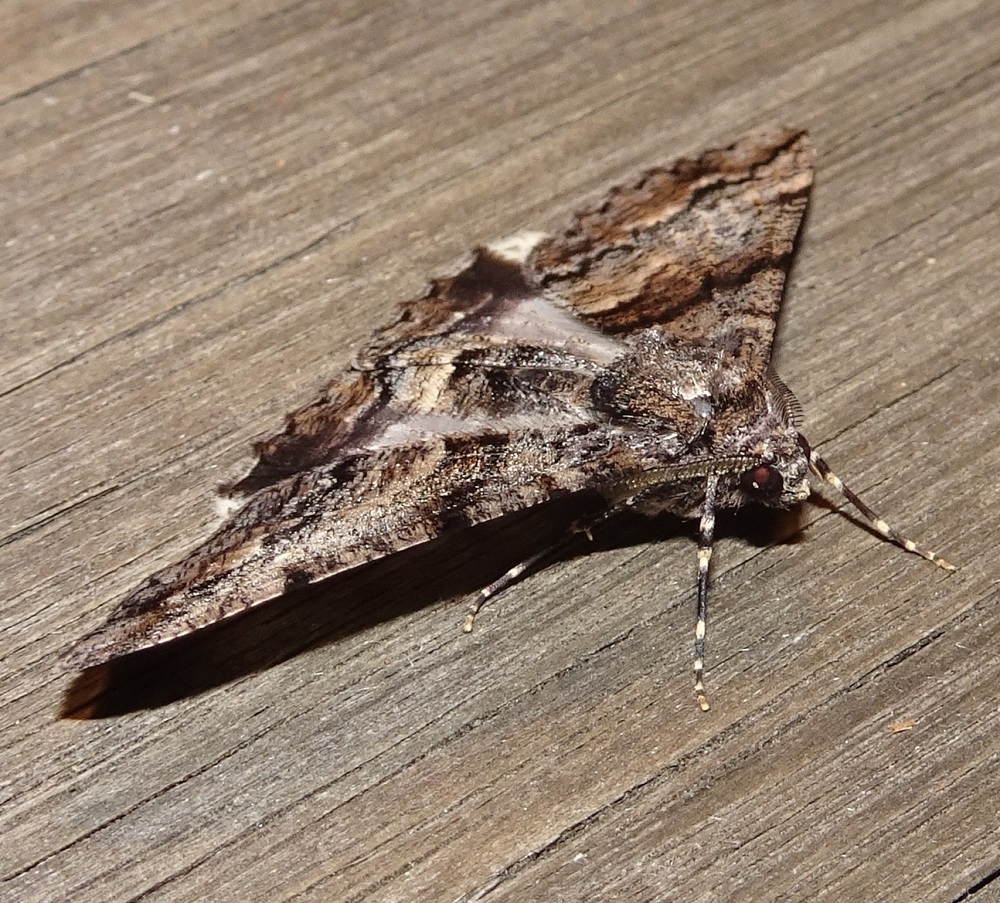

Cryptic Bark Moth Gastrinodes argoplaca
How brilliant is the colour of this Ghost Moth found one warm damp night fluttering at the window? The bright green colour of this one tells us it is a female (along with the simple antennae), the males are a paler blue-green (a more ghostly colour perhaps). The larvae tunnel into the trunks and roots of host trees or shrubs and the adult moths have a wingspan of around 70mm.

Ghost Moth Aenetus eximia
As a child, I can remember finding green tent shaped leafhoppers in the garden which just looked like a leaf until they hopped. I’ve recently discovered some interesting looking Eucalyptus Leafhoppers which seem to be fairly common on juvenile growth of eucalypts and are one of a number of species found in East Gippsland. Leafhoppers are “sap-sucking bugs” and as they feed on the sap from the eucalyptus stem, they produce a by-product called Honeydew. Ants attend the leafhoppers to collect and feed on the sweet honeydew. It is thought the presence of ants helps protect the leafhopper from predators. We call this sort of win-win situation a symbiotic relationship.


Leafhopper (Subfamily Eurymelinae) on a juvenile eucalypt with an attendant ant probably seeking honeydew.
Spiders are not everyone’s favourite sort of wildlife, but just a few weeks into “lockdown” we discovered a dew-covered spider web in the lawn. Dew drops make spiderwebs look so pretty, but on close inspections we could see that this web was full of TINY dots and in the sunshine later we could see these were dozens of tiny spiderlings. We had babies! At the bottom of the web was a tightly woven “floor” of four eucalypt leaves – such a lot of construction work to ensure these young spiders had the right nursery to start their life in.
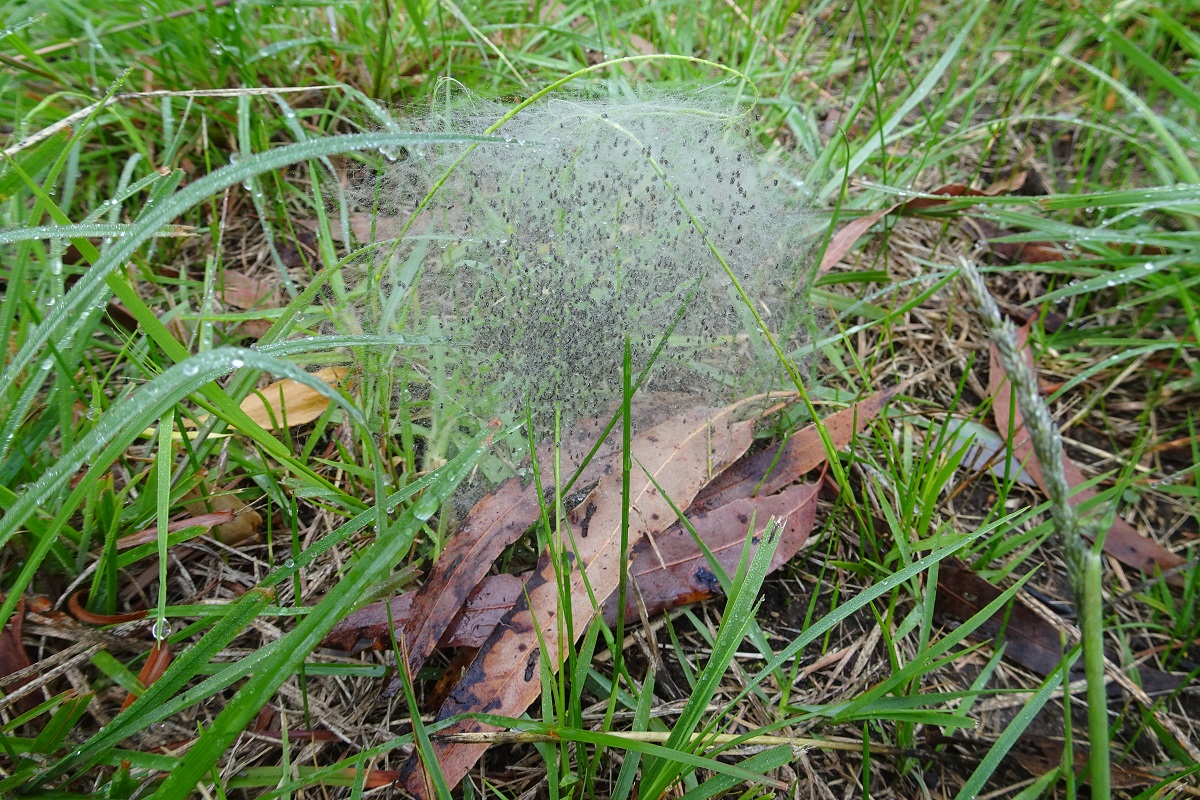 Dew-covered spiderweb with many tiny spiderlings - this was a well set up nursery with leaves woven into the floor.
Dew-covered spiderweb with many tiny spiderlings - this was a well set up nursery with leaves woven into the floor.
Thereafter ensued daily observations of the web and its brood of young spiderlings with many attempts to photograph them – each spiderling was no bigger than the head of a pin – so it was quite a challenge and we did not want to disturb or damage the web either. A small wire cover was put around them to prevent accidental trampling by careless humans or exuberant dogs. On a rainy day we worried that they would not survive, but while many stayed within the web, we could see some had clustered in a tight ball beneath the leaves too. Rain did not seem to be an issue for them. On sunny days they were quite active (making taking photos even more challenging). The web changed a bit over time and as there was no adult spider present we assume the youngsters must have been capable of adding to the web while they continued to use it.

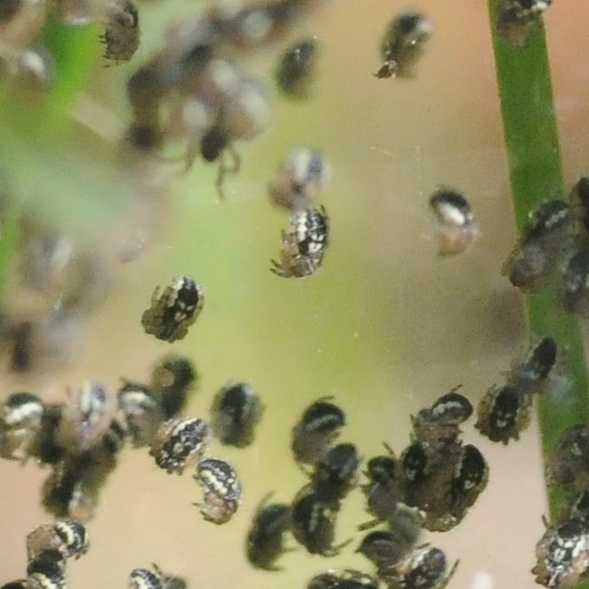
Close up view of the tiny spiderlings in their nursery web showing the face-like markings on their abdomens
We would love to know what species of spider they are but so far have not been able to identify them. There seem to be two different patterns on the dark abdomens. One with just white stripes down the sides and the other with what appears to be a smiley face – two dots and a wide open smiley mouth.


One spiderling out of the web and more in the web on right showing the interesting face-like markings on their abdomen.
They were great daily lockdown entertainment, but after about 2 weeks, the last spiderlings had left the web and we disturbed what was left of the web to investigate the woven leaves at the base. Between the leaves was a very robust fawn-brown egg case made of strong web. It was very strong and held fast between the leaves. What sort of spider makes such a egg case? Not a small one (despite the tiny spiderlings) and as our estimate was that there must have been at least 200 babies. It also is most likely to be a ground dwelling spider rather than one that builds a web high in vegetation. Will we ever find out?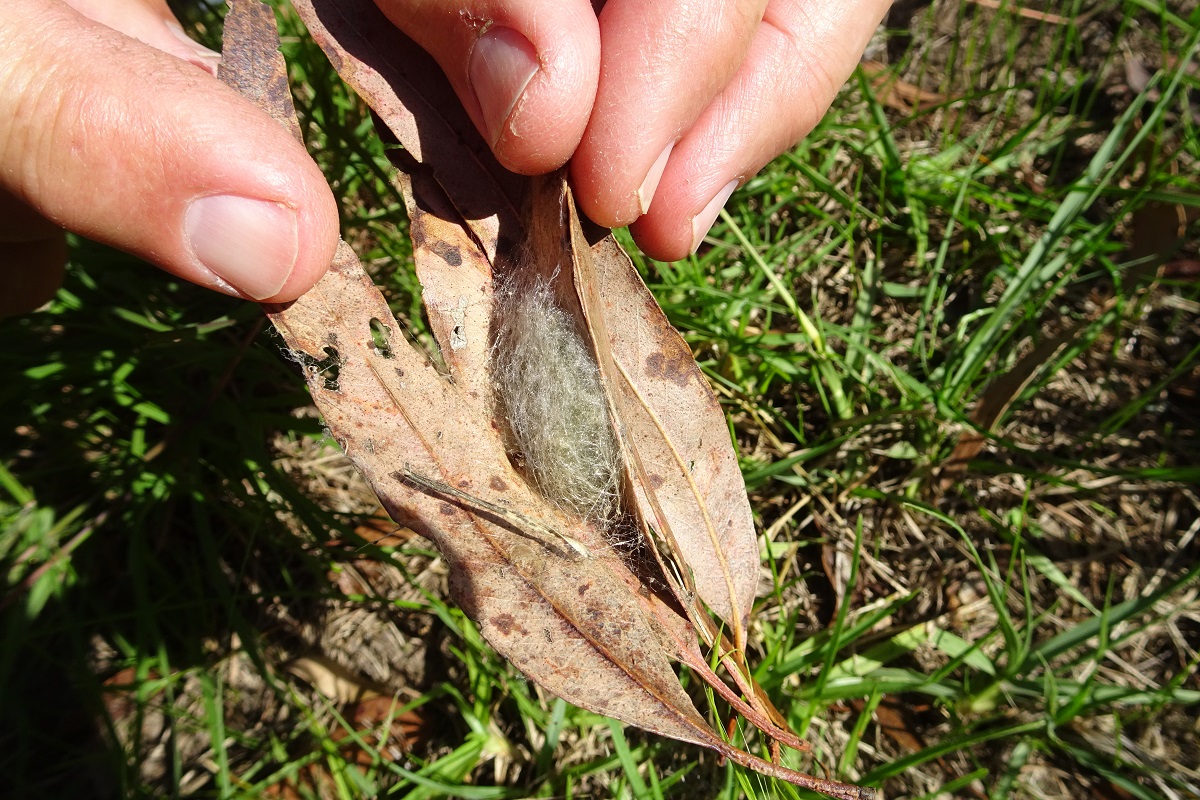
After the spiderlings had all left the web, we found the egg case woven into the leaves at the bottom - what a lot of work!
There seem to be plenty of spiders around this autumn, especially very small ones in the garden and bush. These are a couple more tiny spiders found nestled into the leaves of eucalypts. I don’t know the species names, but they each have very distinctive markings


Left: A pretty pink spider - very tiny. Right: Another small spider with an intricate pattern, perhaps a species of Orb Weaver
I’m pretty sure I have seen this soft grey coloured moth before, usually almost invisible as it presses itself again wood to avoid becoming lunch to a hungry bird during the day while it rests. This one had chosen a gate post and in opening the gate I disturbed it and it dropped to the grass. To my surprise it had very distinctive markings UNDER the wings including some purple colour. Gently putting it back on the fence again it resumed its “you can’t see me” pose.

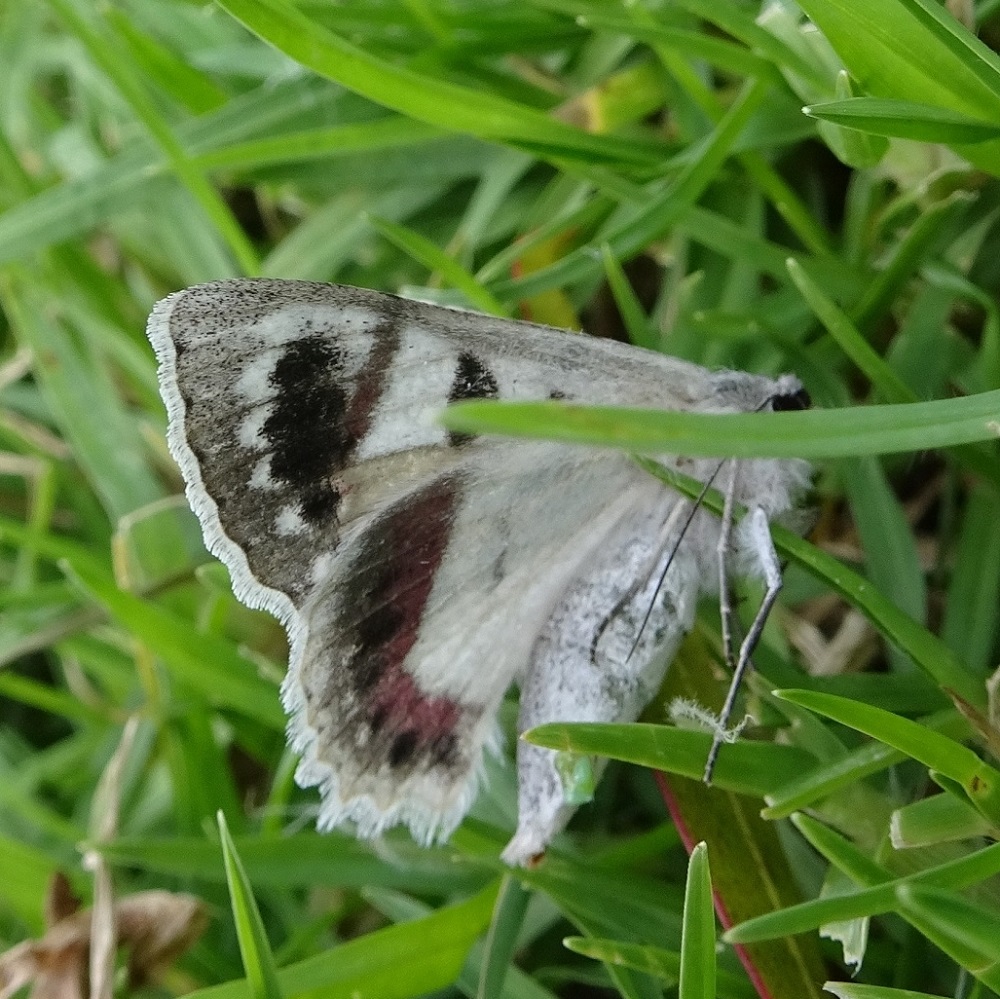
Red-lined Looper Moth, Crypsiphona ocultaria, which like many moths, is expert at camoflague while they rest during the day.
Are you familiar with the green Preying Mantis that are often found in gardens? They are voracious predators of small insects and have powerful front legs used to hold their prey as they eat. This species of mantis is brown and quite new to me. I think it is a wingless female. It was almost armoured-looking and quite small – a good disguise for hiding in bark I expect, but it could run fast – so sorry the photos are not very good. I moved it from the path to the garden where I hope it continues to find insects to eat
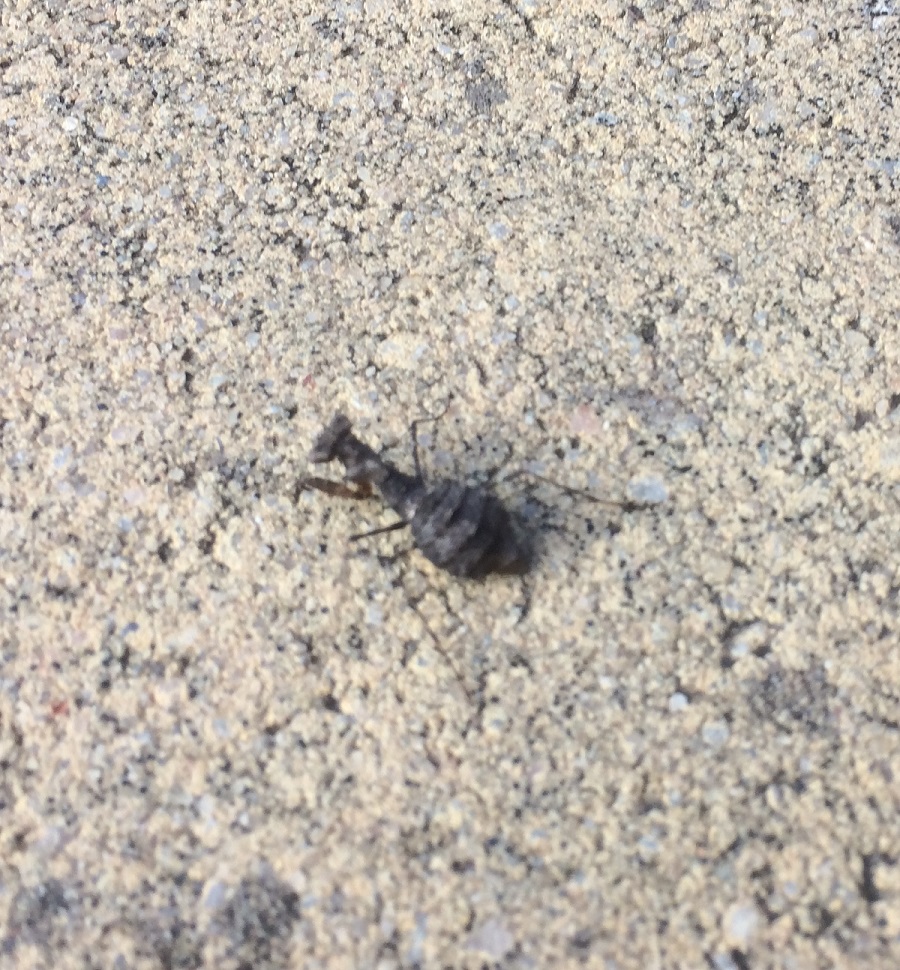

Boxer Bark Mantid Paraoxypilus tasmaniensis
To finish off we have one of our most common butterflies. The Meadow Argus is quite widespread and one we find both at home and on many of our tours. The “Brown” butterflies can be daunting to identify as many of them look similar. However once you get your eye in for the pattern of dots and colour (taking photos is really good for comparison) and as this one is very common – it gradually becomes easier to identify.

Meadow Argus Butterfly, Junonia villida regularly observed across East Gippsland
In order to assist with the knowledge of species distribution, we use iNaturalist to record sightings of invertebrates like these both at home and during our ecotours. It is a great website (or phone app) for amateur naturalists or citizen scientists. You upload a photo with the location and get assistance from subject matter experts to identify it. Once the identification has been verified by two people, your record is confirmed and becomes useful to researchers or anyone interested in distribution of our wildlife.
I hope you have enjoyed this article, we are enjoying keeping up the connections with nature for you via this blog while we cannot share nature with you in person on tours. We might have been in lockdown, but nature never closes – so keep looking when you are outdoors, observing, appreciating and maybe some learning as well.
Jenny Lawrence, May 31, 2020
Go to - Previous story Wildflowers, a look close-up
Go to - Next story Nature's recovery from fire in East Gippsland, the first 6-8 months
Go to - Blog index page
If you would like to leave a comment about this story you can do so on the post about it on our Facebook page and like the page to be notified when the next Blog story is published.